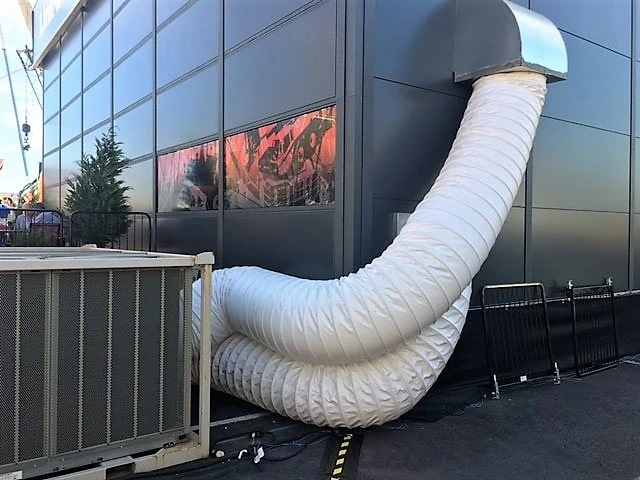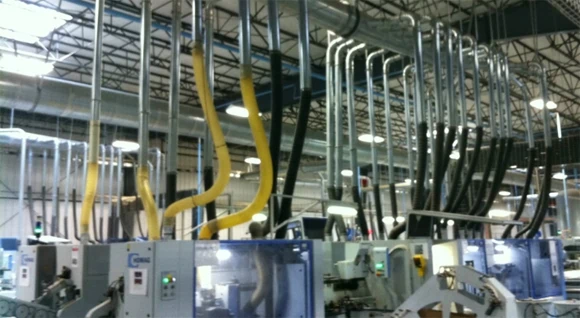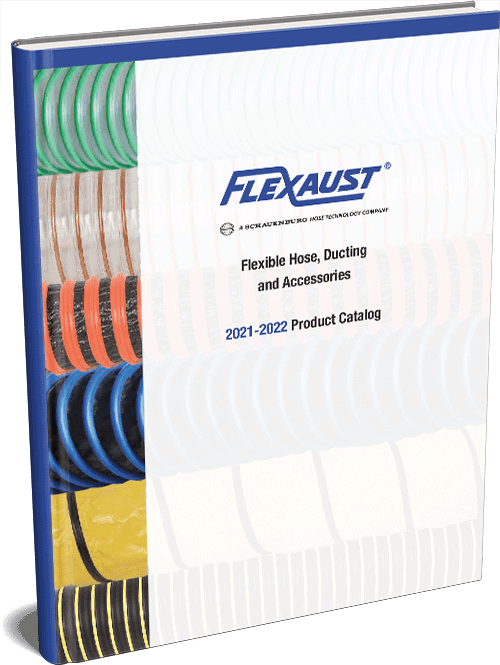Ventilation is a process that improves air quality through a series of air exchanges. Improving air quality depends on the needs of the environment or facility, as the process can involve replenishing oxygen, removing bacteria, reducing carbon dioxide, and/or controlling air temperature. Air ducts are essential to ventilation and are the primary driver in optimizing air quality.
Flexible air ducts come in various compositions, from inexpensive and lightweight materials to heavy-duty tear- and temperature-resistant solutions. At Flexaust, we manufacture flexible hoses and ducting for light to heavy-duty industrial ventilation applications. We offer flexible ducts made of various materials, from flame-retardant industrial ducting to exhaust hoses with high durability and chemical resistance for venting fumes. Flexaust’s flexible ducts meet the demands of numerous ventilation applications, from dust collection in machine shops to fume mitigation in chemical plants.
All air ducts are either positive or negative pressure. While positive air ducts usually have a wider pitch, negative air ducts have a narrower pitch to handle higher vacuum ratings.
This page will help you navigate the various types of ducts and their applications so that you can choose the right flexible ductwork for your needs.
Types of Ducting
There are four main types of ducting depending on the application: general air ducting, fume ducting, dust ducting, and material handling ducting.
Air Ducting
Air ducts transport air throughout a facility, able to accommodate positive or negative air pressure. Lay-flat air ducts are often used for positive air pressure applications. Air ducts are typically constructed with a lightweight helix and fabric. They are not suitable for conveying heavy particulates. Common applications of air ducting include:
- Air drying
- Air filtration
- Cooling and heating
- Dehumidification
- General purpose
Fume Ducting
Fume ducts are lightweight ducts that carry gaseous and other non-particulate media. When selecting the ideal material for a fume duct, consider the type of fume to be vented and the material’s chemical resistance. Typical industries and applications for fume duct systems are:
- Engine exhaust
- Medical
- Soldering
- Painting
- Welding
Dust Ducting
Dust ducting accommodates negative air pressures with a narrower pitch. Since they carry light particulates, dust ducting is typically constructed from medium-weight materials. The specific material selected must be abrasion-resistant enough to handle the type of dust particulate. Examples of abrasion-resistant materials include neoprene-coated polyester, neoprene-coated nylon, EPDM, polypropylene, polyethylene, and polyurethane.
Common applications of dust ducting are:
- Duct cleaning
- Grinding
- Filtration
- Lint collection
- Vacuuming
- Woodworking dust
Material Handling Ducting
To handle heavier particulates, material handling ducts are made of heavyweight materials and thicker walls. Wall thickness, material selection, wire, and pitch depend on the type of material to be handled. Common industries and applications for material handling ducts include:
- Woodworking
- Agriculture
- Food processing
- Waste transport
Duct Materials
Flexible ducts are large-diameter, wire-reinforced round plastic hoses with or without a wearstrip. The non-rigid structure of flexible ducts allows them to bend at an angle for installation in confined spaces. They are also made of lightweight helixes and materials. Flexible ducts can simplify installation, allowing for more convenient shaping of the ductwork. Here are the most common materials used for flexible air ducts:
- PVC-Coated Polyester: A lightweight and highly economical solution, PVC-coated polyester flexible ductwork is ideal for light-duty applications.
- Neoprene-Coated Polyester: Neoprene-coated polyester is a multi-purpose flexible air duct that can operate in a broad temperature range and features good tensile strength and puncture resistance.
- Polyurethane & Polyurethane-Coated Polyester: Both polyurethane and polyurethane-coated polyester air ducts offer a good range of operating temperatures and resistance to abrasion. These flexible ducts are available in various ratios to achieve a specific inner wall smoothness and flexibility.
- Neoprene-Coated Nylon: Neoprene-coated nylon is a heavy-duty flexible air duct offering exceptional tensile strength and tear resistance.
- Neoprene-Coated Fiberglass: This material is a flexible air duct solution that offers good resistance to heat for high-temperature applications.
- Acrylic-Coated Polyester: This is an ideal flexible duct solution for applications with higher temperature ranges.
- Silicone-Coated Fiberglass: Silicone-coated fiberglass ducting is ideal for handling continuous temperatures up to 550 °F and intermittent temperatures up to 600 °F.
Flexaust offers flame retardant ducting and ducting that is listed as UL 94V-0 flame retardant. Our flexible ducting is also highly compressible for greater flexibility and mobility during installation. Many of our products are composed of polyester, which offers improved flexibility to meet the installation demands of facilities with limited space.
Our line of flame-retardant duct hoses has the mobility to maneuver through confined spaces for convenient installation while efficiently moving fumes, dust, air, and abrasives. The ability to compress our fire-rated flexible hoses lengthwise and shrink them slightly in diameter offers extra customizability for ductwork sizes in confined spaces.
Applications and Industries
Many industrial applications rely on flexible ducts and hoses for ventilation. They can exhaust fumes and supply clean or temperature-controlled air. Flexaust offers air ducts and hoses for transporting contaminated and clean air in light- and heavy-duty applications. Our flexible ductwork can also maintain negative or positive air pressure to prevent indoor air quality contamination.
Flexible ductwork is typically composed of a plastic or fabric material stretched over a reinforcing structure. Installers assemble flexible ductwork using clamps, flanges, welding, or slip fitting. Depending on the application, there are various flex duct sizes and configurations. Ventilation systems consist of straight sections, contractions, enlargements, bends, elbows, transitions, discharge stacks, hoods, supports, and hangers.
When determining the ideal flexible duct material for an exhaust application, consider the chemicals, abrasives, or fumes the ductwork may be handling or exposed to during operation. Flexaust’s flexible exhaust ducts are most often used in the following industries and applications:
- Soldering
- Industrial
- Medical
- Painting
- Plating
- Laboratory
- Automotive exhausting in shops, depots, and garages
- Welding exhausting in metal fabrication shops
Vacuum and dust ducts require negative air pressure to remove particles or contaminants from a facility or space. This ductwork should have a narrow pitch. Flexaust carries narrow pitched flexible ducts for the following negative air pressure applications:
- Capturing abrasives and dust from cutting and grinding facilities
- General industrial exhaust
- Cleaning ducts
- Collecting textile fibers
- Loading and containment
- Industrial and commercial vacuum cleaning
- Lint collection from industrial dryers
- Air filtration
Why Flexaust
Ventilation is essential to controlling air quality, exhausting contaminated air, and supplying clean air to a facility or other space. Ductwork is a primary component of any ventilation system, but not all environments are suitable for rigid ductwork. Flexible ducts allow the installation of ductwork in confined and unusually configured spaces. They can turn and bend without kinking and offer performance in harsh industrial conditions.
Flexible ducts can be made of various materials to provide heat-, chemical-, and abrasion-resistant properties while meeting budget and application-specific requirements. Flexible ductwork can handle air, fumes, and abrasive materials in exhaust, negative, and positive air pressure systems. Some of the most common applications for flexible ducts include automotive depots, medical facility exhaust systems, particle collection, industrial vacuum cleaning, and air filtration.
Flexaust started delivering flexible hose systems in 1938, specializing in the mining industry. We are now a leader in flexible hosing and ducting for a broad range of industries. Our flexible ducts and hoses for industrial and commercial use are made to withstand harsh operating conditions, including abrasion, high temperatures, and chemical exposure. We make our products for longevity and dependability, whether you need a ventilation or dust collection solution.
At Flexaust, our team’s “can-do” spirit ensures we can deliver innovative flexible hose and duct solutions that meet or exceed your expectations. Our products continue to innovate and evolve, providing more value to our customers. Contact us to find the ideal flexible duct or hose for your application.




